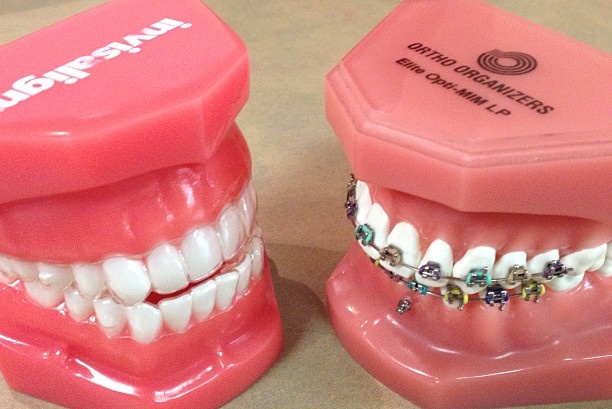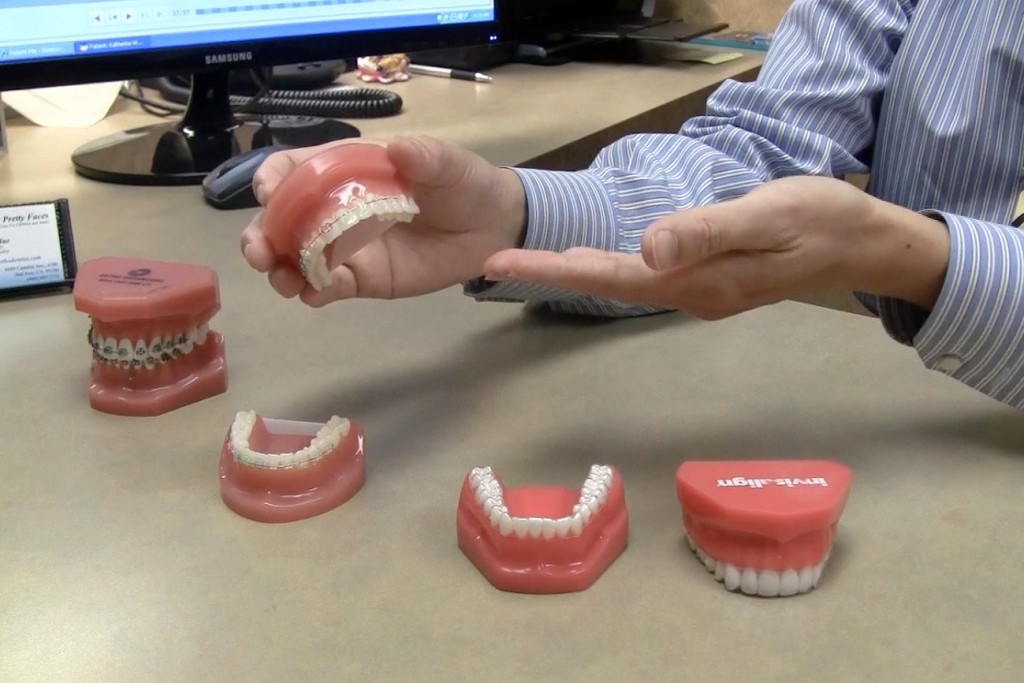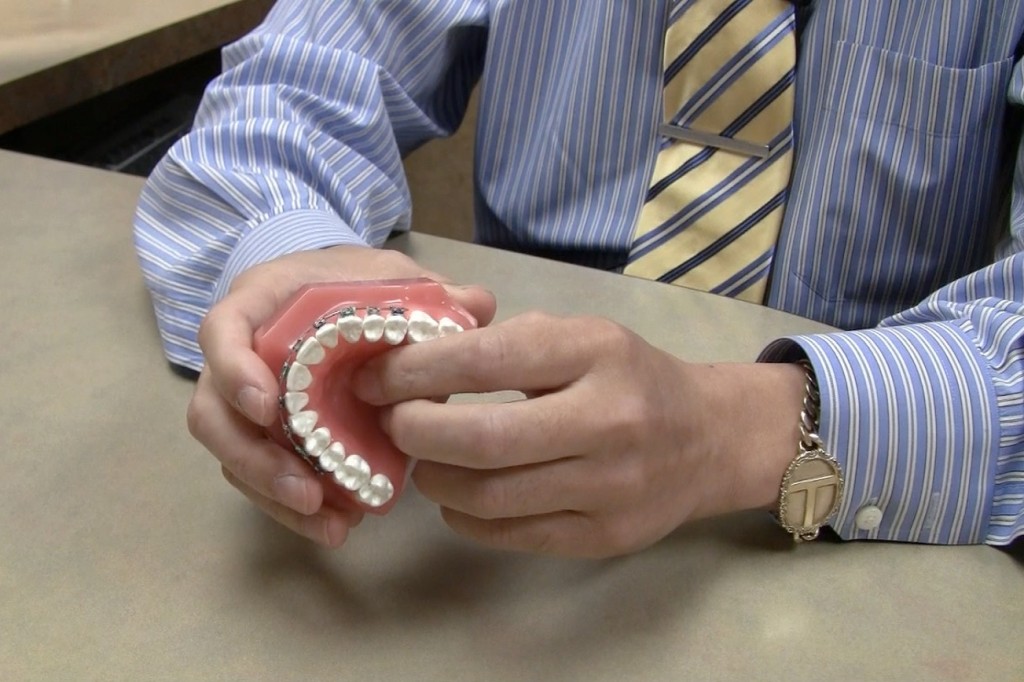
Whether you’re considering braces for your child or yourself, make sure you know the full extent of your options. Photo: Braces for Pretty Faces (2015)
Whether they proactively address dental problems in adolescence or correct them later in life, braces are one of the most effective methods for improving the appearance and functionality of your teeth. If you’re considering braces for your child or yourself, make sure you know the different styles available and the pros and cons of each.
Metal braces
Stainless steel braces are the most basic style, but they’re also the most functional and economical. If you find the prospect of conspicuous metal brackets off-putting, keep in mind that modern brackets are smaller and less prominent than the ones you may have worn in your childhood. Also, for children, the choice of colored bands offers a fun opportunity for self-expression.
There are a few functional drawbacks of traditional braces, like the need to avoid hard or gooey foods and occasional discomfort from protruding wires. However, there’s a good reason this simple style of braces is still around: it continues to deliver the results that orthodontists want to achieve.
Ceramic braces
Ceramic braces function the same way as metal braces, but with clear or tooth-colored brackets that make them less noticeable. While they’re equally effective for straightening teeth, there are a couple of disadvantages that may counter the aesthetic benefits. For one, ceramic braces are more expensive and take longer to install. Also, since the brackets are ceramic rather than metal, they’re more susceptible to breaking, which means wearers have to be even more careful about what they eat. Overall, the time and money that go into maintaining ceramic braces makes them worthwhile only for the most self-conscious of wearers.

Image 2: In general, the less visible a braces system is, the more expensive it is. Photo: Braces for Pretty Faces (2015)
Lingual braces
Unlike traditional braces, which are situated in front of the teeth, lingual braces are situated behind the teeth, effectively hiding them from view. However, despite the obvious cosmetic benefits, lingual braces have several potential drawbacks. First, due to the increased complication of installation, they’re a lot more expensive, and not all orthodontists know how to install them. The main functional disadvantage of lingual braces is that, due to their location in the mouth, they may get in the way of the tongue, potentially causing speech complications and even injury. Additionally, lingual braces are difficult to clean and don’t work well for patients with small teeth.
Invisible braces
These braces aren’t literally invisible, but they’re about as close as it gets. They work a lot differently than traditional braces—rather than brackets cemented onto the teeth, invisible braces systems like Invisalign employ a series of clear plastic, removable aligners that are designed to fit each patient’s bite. Replaced every two weeks, these aligners progressively adjust the patient’s teeth over an extended period of time.
Considering the many advantages of invisible braces (like eliminating hardware installation and food restrictions), it’s not surprising that they’re the most expensive braces system on the market. Additionally, since they lack the sheer force of metal wires and brackets, invisible braces are only able to repair minor discrepancies and aren’t suitable for those with significant dental issues. Invisible braces also tend to take longer to achieve the desired results—on average, therapy lasts up to three years, and in more severe cases, up to five years.

It’s easy to get preoccupied with choosing a style of braces, but a more important consideration is finding the right orthodontist. Photo: Braces for Pretty Faces (2015)
Even though there are many different styles of braces, keep in mind that each has the same function—to straighten teeth. Different orthodontists may prefer a particular style of braces to others, but ultimately, their professional expertise will have the greatest impact on the final outcome. So, rather than being preoccupied with choosing a style of braces, focus on finding a professional who makes you feel comfortable and has the proven ability to deliver successful results.
To find a Diamond Certified dental practice in your area, click on one of the links below.
Alameda County – Dentists
Contra Costa County – Dentists
Marin County – Dentists
San Francisco County – Dentists, Dentist – Implants
Santa Clara County – Dentists, Dentist – Implants, Dental – Orthodontics
Solano County – Dentists
Sonoma County – Dentists
11 Responses
Leave a Reply
You must be logged in to post a comment.

There are a lot of different options when it comes to teeth straightening. It’s important to go through each option, that way you can pick something that will fit your needs. I think braces might be the most common, but you can also look at the other options.
Lingual braces are new to me. I’ve never heard of them before. I can see why some people would be a big fan of not having them on the outside of their teeth. When people say invisible braces, I guess I imagine something like Invisalign. It’s nice that there are more options than when I was a kid.
I am looking at the invisible braces option. I don’t have very much corrective work that needs to happen with my teeth, so I think that it would be a good option, and the last thing that I want as an adult is braces. Do you have an idea of what their cost range is?
Thanks for your post. I was excited to see that invisible braces were an option. However, if they are only able to fix minor discrepancies then they may not work. I’ll have to talk to my orthodontist about it, but invisible braces sound like they will be my firs choice if possible.
I have only had metal braces but good explanation of the different types available. All options are worth a second thought. Thanks so much for sharing!
I’m glad you talked about all the different types of braces there are — I never realized there were so many! It’s great to know your options before even going in to the orthodontist so that you can be prepared to give an answer for which type you want when you get there. My daughter is actually getting braces next week, but we have yet to decide which type we want her to get. The information you gave will really help us narrow it down, though.
I never had braces as a kid, so I don’t know much about orthodontists and the options that are out there for children’s teeth. I know my kids will probably have to have braces, so it’s nice to know that metal braces are the most functional and economical. I bet talking to an orthodontist about our options will allow us to choose the best game plan for each of my kids and their mouth.
I remember when I was looking into braces as a teenager I had the option between metal braces or “invisible” braces. I ended up choosing invisible braces and they worked out great for me. I was fortunate enough to have a n awesome orthodontist who could make them even more invisible for me.
I appreciate you defining the different kinds of braces to consider and what makes them different from each other. I think it’s important to consider the different options to see what is available near you and what would be best for you or your child. Braces are usually around to stay for a while. I agree with you that it’s just as important to find a professional who you are comfortable with as it is to find the right kind of braces.
I didn’t realize that you can get ceramic braces. It is cool that they are the same color as your teeth. That would probably be a great option for people who are self-conscious.
I didn’t know you could get braces on the back of your teeth instead of the front! My brother is looking into getting braces and I wanted to look into it so I could help out, I’m glad I did. It makes sense that in order to get the results you want and the best treatment option for your specific case, it is a good idea to consult with a professional you trust and who can work with your insurance company.